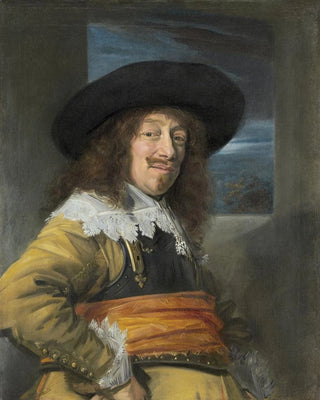Portrait of a member of the Haarlem civic guard - Frans Hals | Art print


View from behind

Frame (optional)
Portrait of a member of the Haarlem civic guard - Frans Hals – Captivating introduction
The "Portrait of a member of the Haarlem civic guard" by Frans Hals is an iconic artwork that embodies the spirit of a bygone era and a vibrant city. Created in the 17th century, this painting transports us into the lively universe of Holland, where civic and military life intertwine with fascinating ease. Through this portrait, the artist manages to capture not only the physical appearance of his subject but also the very essence of his character, revealing a rare psychological depth. The scene is imbued with a dynamic energy that draws the eye, inviting the viewer to ponder the identity of this man while offering a glimpse into the Dutch society of the time.
Style and uniqueness of the work
Frans Hals, master of the portrait, stands out for his bold style and innovative painting technique. In this piece, he employs swift, fluid brushstrokes that infuse the depicted character with striking vitality. The interplay of light and shadow creates a vivid contrast, highlighting the details of the uniform and facial features. The confident posture of the civic guard, slightly in profile, suggests pride and commitment, while his gaze, both piercing and contemplative, engages the viewer in a silent dialogue. The richness of the colors, from subtle shadows to luminous highlights, demonstrates technical mastery that makes Hals a pioneer of Baroque painting. This work, through its realism and expressiveness, distinguishes itself from the conventions of its time, turning each portrait into a story in its own right.
The artist and his influence
Frans Hals, born in Antwerp in 1582, is one of the most influential artists of the Dutch Golden Age. His career, spanning several decades, is marked by a constant evolution of his style, ranging from formal portraits to more lively and spontaneous works. Hals captured the spirit of his era by highlighting subjects from the middle class and bourgeoisie, while endowing them with dignity and humanity that transcend mere portraiture. His innovative approach has inspired many artists, both contemporaries

Matte finish

View from behind

Frame (optional)
Portrait of a member of the Haarlem civic guard - Frans Hals – Captivating introduction
The "Portrait of a member of the Haarlem civic guard" by Frans Hals is an iconic artwork that embodies the spirit of a bygone era and a vibrant city. Created in the 17th century, this painting transports us into the lively universe of Holland, where civic and military life intertwine with fascinating ease. Through this portrait, the artist manages to capture not only the physical appearance of his subject but also the very essence of his character, revealing a rare psychological depth. The scene is imbued with a dynamic energy that draws the eye, inviting the viewer to ponder the identity of this man while offering a glimpse into the Dutch society of the time.
Style and uniqueness of the work
Frans Hals, master of the portrait, stands out for his bold style and innovative painting technique. In this piece, he employs swift, fluid brushstrokes that infuse the depicted character with striking vitality. The interplay of light and shadow creates a vivid contrast, highlighting the details of the uniform and facial features. The confident posture of the civic guard, slightly in profile, suggests pride and commitment, while his gaze, both piercing and contemplative, engages the viewer in a silent dialogue. The richness of the colors, from subtle shadows to luminous highlights, demonstrates technical mastery that makes Hals a pioneer of Baroque painting. This work, through its realism and expressiveness, distinguishes itself from the conventions of its time, turning each portrait into a story in its own right.
The artist and his influence
Frans Hals, born in Antwerp in 1582, is one of the most influential artists of the Dutch Golden Age. His career, spanning several decades, is marked by a constant evolution of his style, ranging from formal portraits to more lively and spontaneous works. Hals captured the spirit of his era by highlighting subjects from the middle class and bourgeoisie, while endowing them with dignity and humanity that transcend mere portraiture. His innovative approach has inspired many artists, both contemporaries
12,34 €






